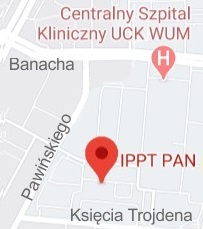| 1. |
Le T.N.B.♦, Nguyen T., Do M.♦, Phung H.N.T.♦, Le V.T.♦, Negative electronic compressibility in MoS2 monolayers,
PHYSICA B-CONDENSED MATTER, ISSN: 0921-4526, DOI: 10.1016/j.physb.2025.418022, Vol.720, pp.418022-1-10, 2026 Streszczenie:
The Coulomb-driven renormalization of electronic compressibility in monolayer MoS2 remains poorly understood at finite temperatures. Using the Rytova–Keldysh potential with a nonlocal dielectric response, we calculate the compressibility as a function of carrier density and temperature in experimentally relevant regimes. The exchange and correlation energies are treated, respectively, within the noninteracting (NI), Hartree–Fock (HF), and random phase approximation (RPA) frameworks. We demonstrate that the RPA, through enhanced screening induced by many-body correlations, yields negative values of the electronic compressibility,
in agreement with recent measurements resolved in temperature and density. At high temperatures ( Słowa kluczowe:
Graphene, Quantum well, TMDCs, Compressibility TMDCs, Capacity quantum Afiliacje autorów:
| Le T.N.B. | - | inna afiliacja | | Nguyen T. | - | IPPT PAN | | Do M. | - | inna afiliacja | | Phung H.N.T. | - | inna afiliacja | | Le V.T. | - | inna afiliacja |
|  | 70p. |
| 2. |
Nguyen T., Le T.N.B.♦, Phung H.N.T.♦, Le V.T.♦, Effects of electron-electron interactions on quasiparticle properties in transition-metal dichalcogenides monolayers,
Physical Review B, ISSN: 2469-9969, DOI: 10.1103/q18p-1mbk, pp.1-40, 2025 Streszczenie:
Coulomb-driven renormalization of electronic spectra in monolayer transition-metal dichalcogenides (TMDCs) remains poorly understood at finite temperature. Using the Rytova-Keldysh potential with a non-local dielectric response, we calculate quasiparticle band-gap renormalization (BGR) and the Fermi-edge absorption spectrum over experimentally relevant carrier densities and temperatures. Exchange and correlation self-energies are treated successively within Hartree-Fock (HF), the random-phase approximation (RPA), and the Hubbard local-field approximation (HFA). Only the HFA, which embeds the G(q) local-field factor, reproduces recent temperature- and densityresolved measurements: it broadens the band gap at low densities and produces a density-induced redshift of the Fermi absorption edge through enhanced screening. The same framework accounts for the nonmonotonic BGR observed in cyclotron resonance experiments on disordered monolayers when disorder-induced thermal broadening is included. The results establish a local-field-corrected many-body theory as the minimal quantitative description of carrier-doped TMDCs and provide a roadmap for engineering interaction-driven electronic phases in two dimensions. Afiliacje autorów:
| Nguyen T. | - | IPPT PAN | | Le T.N.B. | - | inna afiliacja | | Phung H.N.T. | - | inna afiliacja | | Le V.T. | - | inna afiliacja |
|  | 140p. |
| 3. |
Ślusarz R.♦, Sieradzan A.♦, Giełdoń A.♦, Lubecka E.♦, Ślusarz M.♦, Leśniewski M.♦, Nguyen T.♦, Liwo A.♦, Czaplewski C.♦, UNRES web server: Extensions to nucleic acids, prediction of peptide aggregation, and new types of restrained calculations,
Journal of Molecular Biology, ISSN: 0022-2836, DOI: 10.1016/j.jmb.2025.168968, Vol.437, No.15, pp.168968-1-9, 2025 Streszczenie:
The third version of the UNRES web server is described, in which the range of biological macromolecules treated and calculation types has been extended significantly. DNA and RNA molecules have been added to enable the user to run simulations of their folding/hybridization and dynamics. To increase the accuracy of the simulated proteins models, the restraints on secondary structure have been enhanced to include the probabilities of the coil, extended and helical state, which are taken from the PSIPRED or HHpred raw input and the restraints from multiple bioinformatics models have been added. The NMR-data-assisted functionality has been extended to include time-averaged restraints, this feature enabling the user to model multistate and intrinsically-disordered proteins and those with intrinsically-disordered regions. Finally, the prediction of the propensity of peptides to aggregation has been included to enable the user to predict peptide solubility and aggregation, including the character and the structures of the aggregates. Słowa kluczowe:
protein and nucleic-acid structure prediction, peptide aggregation, coarse graining, molecular dynamics, time-averaged NMR Afiliacje autorów:
| Ślusarz R. | - | inna afiliacja | | Sieradzan A. | - | inna afiliacja | | Giełdoń A. | - | inna afiliacja | | Lubecka E. | - | inna afiliacja | | Ślusarz M. | - | inna afiliacja | | Leśniewski M. | - | inna afiliacja | | Nguyen T. | - | inna afiliacja | | Liwo A. | - | inna afiliacja | | Czaplewski C. | - | inna afiliacja |
|  | 140p. |
| 4. |
Nguyen T., Dat L.♦, Le V.T.♦, Finite-temperature properties of monolayer MoS2: Role of electron-electron interactions,
Physical Review B, ISSN: 2469-9969, DOI: 10.1103/PhysRevB.111.155415, Vol.111, No.15, pp.155415-1-14, 2025 Streszczenie:
We theoretically investigate electron-electron interaction effects on the single-particle Green's function of doped monolayer MoS2, employing a massless Dirac continuum model within the random phase approximation and incorporating long-range Coulomb interactions via a modified Keldysh potential. Our calculations provide quantitative predictions for the many-body spectral function, the renormalized quasiparticle energy dispersion, and the renormalized velocity at both zero and finite temperatures, taking into account carrier density, electric field intensity, and spin polarization. We identify experimentally detectable many-body signatures that are substantially enhanced with decreasing carrier density, electric field, and spin polarization, alongside intriguing instabilities in the excitation spectrum at small wave vectors where interactions completely destroy the noninteracting linear dispersion. The velocity renormalization exhibits a leading-order temperature correction that is linear and positive, with a universal, density-independent slope in the high-density limit. We further predict an enhanced effective velocity at low temperatures and a nonmonotonic temperature dependence at higher temperatures (e.g. Afiliacje autorów:
| Nguyen T. | - | IPPT PAN | | Dat L. | - | inna afiliacja | | Le V.T. | - | inna afiliacja |
|  | 140p. |
| 5. |
Nguyen T.♦, Czaplewski C.♦, Lubecka E.♦, Liwo A.♦, Implementation of Time-Averaged Restraints with UNRES Coarse-Grained Model of Polypeptide Chains,
Journal of Chemical Theory and Computation, ISSN: 1549-9618, DOI: 10.1021/acs.jctc.4c01504, Vol.21, No.3, pp.1476-1493, 2025 Streszczenie:
Time-averaged restraints from nuclear magnetic resonance (NMR) measurements have been implemented in the UNRES coarse-grained model of polypeptide chains in order to develop a tool for data-assisted modeling of the conformational ensembles of multistate proteins, intrinsically disordered proteins (IDPs) and proteins with intrinsically disordered regions (IDRs), many of which are essential in cell biology. A numerically stable variant of molecular dynamics with time-averaged restraints has been introduced, in which the total energy is conserved in sections of a trajectory in microcanonical runs, the bath temperature is maintained in canonical runs, and the time-average-restraint-force components are scaled up with the length of the memory window so that the restraints affect the simulated structures. The new approach restores the conformational ensembles used to generate ensemble-averaged distances, as demonstrated with synthetic restraints. The approach results in a better fitting of the ensemble-averaged interproton distances to those determined experimentally for multistate proteins and proteins with intrinsically disordered regions, which puts it at an advantage over all-atom approaches with regard to the determination of the conformational ensembles of proteins with diffuse structures, owing to a faster and more robust conformational search. Afiliacje autorów:
| Nguyen T. | - | inna afiliacja | | Czaplewski C. | - | inna afiliacja | | Lubecka E. | - | inna afiliacja | | Liwo A. | - | inna afiliacja |
|  | 140p. |
| 6. |
Le V.T.♦, Do M.♦, Nguyen Truong C., Many-body exchange–correlation effects on the lowest energy states of MoS2 monolayers at finite temperatures,
COMPUTATIONAL MATERIALS SCIENCE, ISSN: 0927-0256, DOI: 10.1016/j.commatsci.2025.114058, Vol.258, pp.114058-1-13, 2025 Streszczenie:
The electronic properties of monolayer two-dimensional are strongly influenced by the presence of a perpendicular electric field (), finite temperature (), an externally applied spin-polarized exchange field (), and spin-valley coupling effects () induced by surface adatoms or magnetic proximity interactions with a ferromagnetic substrate. Within the framework of the Random Phase Approximation (RPA), we investigate how these external fields reshape electron–electron interactions and provide both analytical and numerical results for the density of states (DOS), quantum capacitance, and effective Fermi velocity. Our findings show that the interplay between , , and leads to the emergence of a spin-valley coupling dependent self-energy structure in the charge carriers, resulting in pronounced spin- and valley-polarized behavior of the effective Fermi velocity. Our predictions agree well with available experimental data and reveal that the Fermi velocity can be tuned via spin polarization, enriching the qualitative and quantitative understanding of quantum effects in these materials. Słowa kluczowe:
ffective velocity Fermi,Quantum capacity,Dos,Quantum well,TMDC Afiliacje autorów:
| Le V.T. | - | inna afiliacja | | Do M. | - | inna afiliacja | | Nguyen Truong C. | - | IPPT PAN |
|  | 100p. |
| 7. |
Leśniewski M.♦, Pyrka M.♦, Czaplewski C.♦, Nguyen Truong C.♦, Jiang Y.♦, Gong Z.♦, Tang C.♦, Liwo A.♦, Assessment of Two Restraint Potentials for Coarse-Grained Chemical-Cross-Link-Assisted Modeling of Protein Structures,
Journal of Chemical Information and Modeling, ISSN: 1549-9596, DOI: 10.1021/acs.jcim.3c01890, Vol.64, No.4, pp.1377-1393, 2024 Streszczenie:
The influence of distance restraints from chemical cross-link mass spectroscopy (XL-MS) on the quality of protein structures modeled with the coarse-grained UNRES force field was assessed by using a protocol based on multiplexed replica exchange molecular dynamics, in which both simulated and experimental cross-link restraints were employed, for 23 small proteins. Six cross-links with upper distance boundaries from 4 Å to 12 Å (azido benzoic acid succinimide (ABAS), triazidotriazine (TATA), succinimidyldiazirine (SDA), disuccinimidyl adipate (DSA), disuccinimidyl glutarate (DSG), and disuccinimidyl suberate (BS3)) and two types of restraining potentials ((i) simple flat-bottom Lorentz-like potentials dependent on side chain distance (all cross-links) and (ii) distance- and orientation-dependent potentials determined based on molecular dynamics simulations of model systems (DSA, DSG, BS3, and SDA)) were considered. The Lorentz-like potentials with properly set parameters were found to produce a greater number of higher-quality models compared to unrestrained simulations than the MD-based potentials, because the latter can force too long distances between side chains. Therefore, the flat-bottom Lorentz-like potentials are recommended to represent cross-link restraints. It was also found that significant improvement of model quality upon the introduction of cross-link restraints is obtained when the sum of differences of indices of cross-linked residues exceeds 150. Afiliacje autorów:
| Leśniewski M. | - | inna afiliacja | | Pyrka M. | - | inna afiliacja | | Czaplewski C. | - | inna afiliacja | | Nguyen Truong C. | - | inna afiliacja | | Jiang Y. | - | inna afiliacja | | Gong Z. | - | inna afiliacja | | Tang C. | - | inna afiliacja | | Liwo A. | - | inna afiliacja |
|  | 100p. |
| 8. |
Thu T.♦, Phung H.N.T.♦, Nguyen T.♦, Kloczkowski A.♦, Li M.♦, Key Factors Controlling Fibril Formation of Proteins,
ACTA PHYSICA POLONICA A, ISSN: 0587-4246, DOI: 10.12693/APhysPolA.145.S21, Vol.145, No.3, pp.S21-S36, 2024 Streszczenie:
Fibril formation resulting from protein aggregation is a hallmark of a large group of neurodegenerative human diseases, including Alzheimer's disease, type 2 diabetes, amyotrophic lateral sclerosis, and Parkinson's disease, among many others. Key factors governing protein fibril formation have been identified over the past decades to elucidate various facets of misfolding and aggregation. However, surprisingly little is known about how and why fibril structure is achieved, and it remains a fundamental problem in molecular biology. In this review, we discuss the relationship between fibril formation kinetics and various characteristics, including sequence, mutations, monomer secondary structure, mechanical stability of the fibril state, aromaticity, hydrophobicity, charge, and population of fibril-prone conformations in the monomeric state. Słowa kluczowe:
protein fibril formation, aggregation rate, neurodegenerative diseases, amyloid beta peptides Afiliacje autorów:
| Thu T. | - | inna afiliacja | | Phung H.N.T. | - | inna afiliacja | | Nguyen T. | - | inna afiliacja | | Kloczkowski A. | - | inna afiliacja | | Li M. | - | inna afiliacja |
|  | 70p. |

























